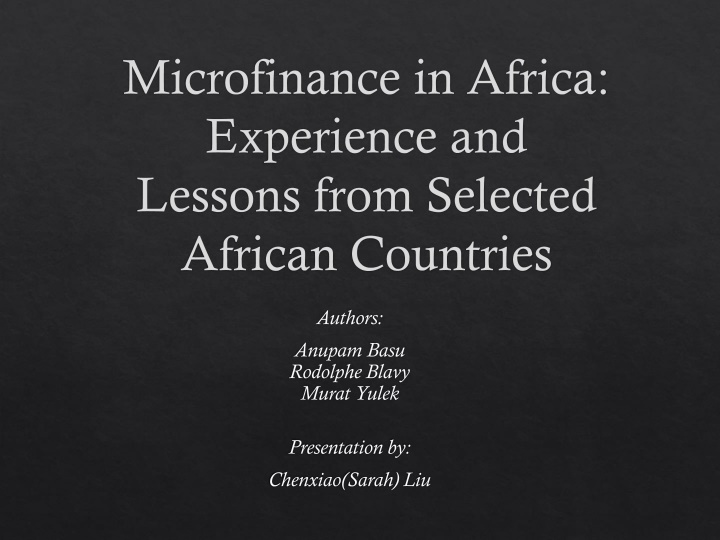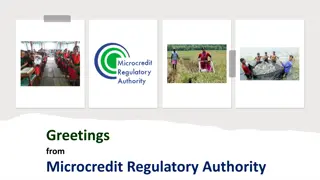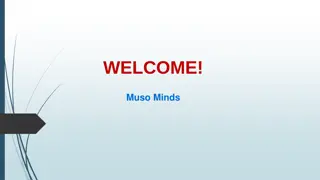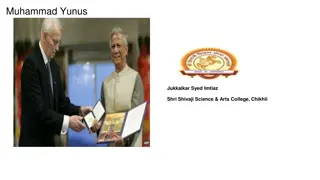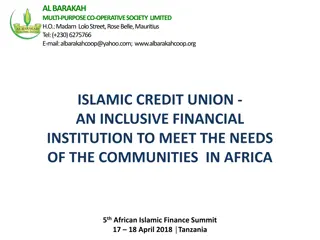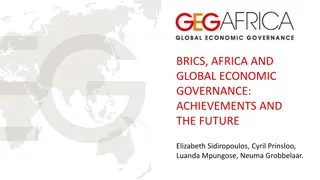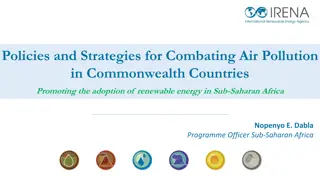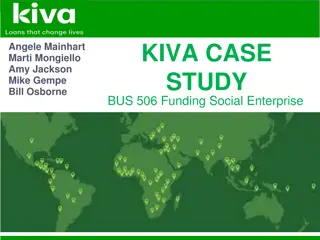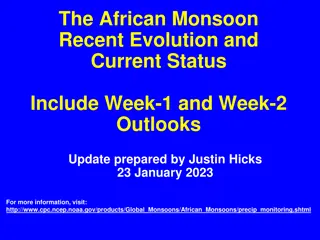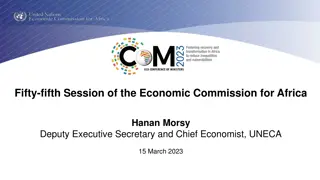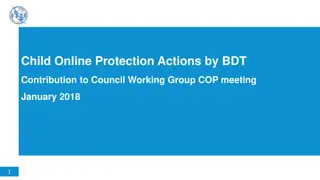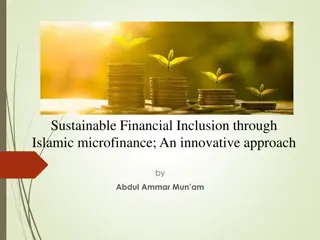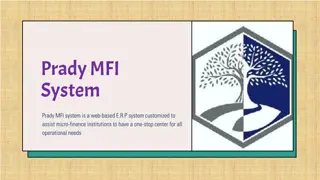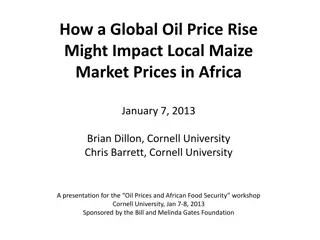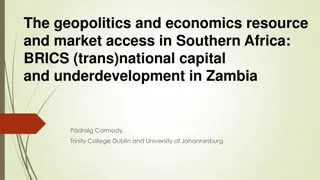Microfinance in Africa: Lessons and Experiences from Selected Countries
Exploring the role of Microfinance Institutions (MFIs) in Africa, this study delves into the challenges faced by small enterprises and households in accessing formal financial services. Through case studies in Benin, Ghana, Guinea, and Tanzania, the report highlights the significance of MFIs in providing secure savings options, credit extensions, and promoting financial sustainability for underprivileged communities. The research underscores the potential for MFIs to empower local economies and drive poverty reduction efforts across the continent.
Uploaded on Oct 04, 2024 | 1 Views
Download Presentation

Please find below an Image/Link to download the presentation.
The content on the website is provided AS IS for your information and personal use only. It may not be sold, licensed, or shared on other websites without obtaining consent from the author.If you encounter any issues during the download, it is possible that the publisher has removed the file from their server.
You are allowed to download the files provided on this website for personal or commercial use, subject to the condition that they are used lawfully. All files are the property of their respective owners.
The content on the website is provided AS IS for your information and personal use only. It may not be sold, licensed, or shared on other websites without obtaining consent from the author.
E N D
Presentation Transcript
Microfinance in Africa: Experience and Lessons from Selected African Countries Authors: Anupam Basu Rodolphe Blavy Murat Yulek Presentation by: Chenxiao(Sarah) Liu
Contents Introduction Deposit Collection and Credit Extension in the Microfinance Sector Links Between the Operations of MFIs and Banks, Donors and NGOs The Role of Governments Conclusion Critics
Introduction Backgrounds: Small enterprises limited access to formal financial institutions. Microfinance Institutions (MFIs) has emerged microfinance institutions - dedicated to assisting small enterprises, the poor, and households who have no access to the more institutionalized financial system and financial services. Commercial banks, state-owned development banks, and postal offices. Four countries selected Benin, Ghana, Guinea, and Tanzania. Contribution compare experiences across Africa, and identify patterns that may guide public policy in the sector
Deposit Collection and Credit Extension Deposit Collection Development poor value availability of liquid and secure financial vehicles for saving lean and peak harvesting seasons, exogenous shocks. pay for inputs at the start of production processes, and self-finance future investments or leverage supplementary financing for them. setting aside money for costly future events. MFIs have the advantage of security and liquidity
Deposit Collection and Credit Extension Four major criteria access, security, liquidity, and returns Three main barriers to the use of the deposit facilities high opening and minimum account balances high travel time and transport costs involved in making deposits and withdrawals at the bank branch lack of familiarity with bank branch operations and procedures. Approaches The Community-Based Approach in MFI Development Formalizing Informal Methods of Financial Intermediation Looking for Financial Sustainability
Deposit Collection and Credit Extension APCH1 - The Community-Based Approach in MFI Development Rely on local communities -> traditional community-based cooperative groups such as local clubs and village associations Benefits Clients: Constitute larger collaterals and enhance access to credit services. Institutions: A less constrained market-based approach to the management of both sides of the balance sheet. They could promote more efficient intermediation. Macroeconomic level: Increase domestic financial savings mobilization. Social impact: Empower underprivileged social constituencies to contribute to economic development and poverty reduction.
Deposit Collection and Credit Extension APCH1 - The Community-Based Approach in MFI Development Village Banking Use of group solidarity and of the linkage between saving and credit instruments Loans are made to groups of ten members, but benefiting only half of them at a time, and the rest only after repayment. Other approaches Group of members mobilize and pool their savings jointly to qualify for a loan and may then use group savings as security against loans. With credit scheme, group and individual savings accounts coexist, both of which can be used as collateral. Group savings provide an additional security to back an individual loan. Loan repayments are made individually but handled through the group account. With individual savings with group lending, the group bears responsibility for recovery. Individual approach may prevail if established a credible credit history, or when group approach is not appropriate.
Deposit Collection and Credit Extension APCH2 - Formalizing Informal Methods of Financial Intermediation Licensed MFIs have benefited in Savings mobilization methods developed by informal savings collectors can be replicated. Informal savings collectors provide an additional layer in the structure of the microfinance system. Eg: susu system
Deposit Collection and Credit Extension APCH3 - Looking for Financial Sustainability Formalization of informal techniques and group-based instruments Addressing asymmetry of information, lack of collateral, and difficult enforcement of legal rights, etc. group-based microfinance techniques -> portfolio performance problems experienced with individual loans Group lending with joint liability -> problem of imperfect information faced by the lender Risk: contagion, coordination failure problem Do MFI acchieved? Benin SLCs (saving and loan cooperatives) were able to substantially expand their deposits and loan portfolios, recover their nonperforming loans, and achieve break-even or positive net profits in their current operations
Links Between the Operations of MFIs and Banks, Donors and NGOs Developing Complementarities between MFIs and Banks Banks lend and collect deposits mostly from formal private sector and to the government. MFIs service poor and rural households, and small entrepreneurs often in the informal sector. Both benefit from a closer relationship MFIs reap benefits as clients of commercial banks Banks manage MFIs deposit accounts, provide liquidity management services Extended credit facilities allow MFIs to expand their services. Work together in providing financial services. Strengthen the links between the formal and informal sectors
Links Between the Operations of MFIs and Banks, Donors and NGOs The Roles of Donors and NGOs Provide support: credit-only schemes domestic NGOs or donor-managed microfinance projects microfinance institutions that function more or less like leasing companies (receiving wholesale external resources and lending to clients) Promote investment and hence enhance economic growth Critics: weaken financial discipline in MFIs, constrain growth and sustainability, crowd out commercially viable projects that not qualify for donor funds. Suggestion: Encourage to build resource base through domestic saving mobilization. Focus on social programs and services, including programs aimed at reducing poverty
The Role of Governments Failed state-owned banks has led governments focus on providing microfinance and developing regulatory and supervision frameworks. Regulatory System: easy entry -> weak performance->tightening up of regulation and restructuring. Moral hazard problem addressed. Donors involved -> alleviate financial burden on the government and provide technical assistance at the institutional and supervisory levels.
The Role of Governments Objectives and Coverage of the Regulatory Framework Create a healthy environment for microfinance activities while not stifling the growth of the sector. Frameworks need to be well adapted and flexibility designed to reflect the specific characteristics and the stage of evolution. Benin VS. Guinea Size and linkages may increase systemic risks is a key consideration in the design of prudential legislation. The stages MFI evolve during their life cycles are also important in the design of regulatory frameworks. semi-formalizing VS. fully formalizing semiformal institutions An apex or umbrella institution for the microfinance sector to coordinate and supervise their activities.
The Role of Governments Minimum Regulatory Requirements and Supervision Practices Principal regulatory requirements licensing, information transmission requirements, and prudential norms Gradual approach: newer and smaller institutions VS. larger institutions Suggest: Prudential rules for larger institutions include capital requirements (minimum capital limit, minimum retained earnings), risk concentration limits (on single borrowers), liquidity limits, and well-defined provisioning requirements .
Conclusion In sub-Saharan Africa, the poor value both deposit and credit facilities. The existence and growth of cooperative banking and combined savings and credit institutions in the microfinance sector reflects the growing demand for both savings and credit facilities. There are strong beneficial linkages between formal and informal microfinance institutions (MFIs). Donors and NGOs have played an important supportive role in the development of MFIs. Governments play a key role in promoting the microfinance sector. Main constraints Lack of bookkeeping and reporting standards, internal controls, and credit decision mechanisms at the level of the MFIs. The level of the institutions entrusted with supervision authority, mainly due to shortage of skilled and trained staff. Information or database on borrowers, their credit history, and repayment records has not kept pace with the growth of the microfinance sector.
Critics Not much research done on the actual effectiveness. There s also some microfinance institutions charging excessive interest rates. Studies of microcredit programs have found that women often act as collection agents for their husbands and sons, such that the men spend the money themselves while women are saddled with the credit risk. Weather it should focus on improved welfare or financial sustainability. High cost of regulatory - authorities will need to supervise a growing number of MFI s, which are small, numerous, located in remote regions, and have poor record keeping.
